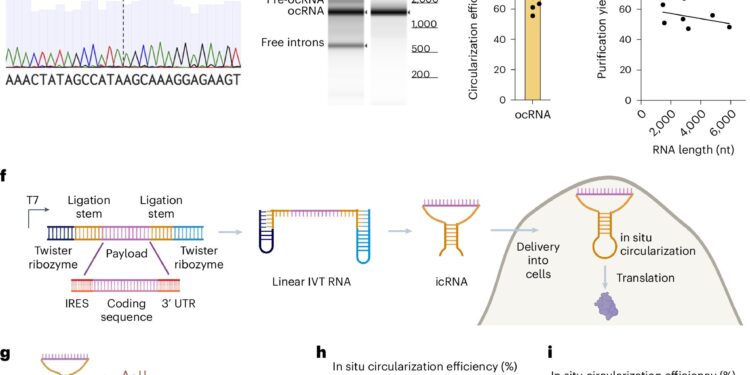Engineering of RNAc and RNAi. Credit: Nature Biomedical Engineering (2024). DOI: 10.1038/s41551-024-01245-z
New methods for shaping RNA molecules into circles could lead to more effective and longer-lasting therapies, according to a study by researchers at the University of California, San Diego. The advance holds promise for a range of diseases, offering a more sustainable alternative to existing RNA-based therapies, which often suffer from short-lived effectiveness in the body.
The book is published in Nature Biomedical Engineering.
RNA molecules have become powerful tools in modern medicine. They can silence genes using small interfering RNAs (siRNAs) or serve as templates for making therapeutic proteins, as is the case with messenger RNAs (mRNAs). Unlike gene editing technologies, which make permanent changes to DNA, RNA-based therapies offer a temporary but highly targeted approach.
However, one of the main challenges is that RNAs do not last long in the body, which limits their effectiveness. The concept of circular RNA (cRNA) has gained popularity as a solution to this problem. Circular RNAs, unlike their linear counterparts, have a closed-loop structure that makes them more resistant to degradation. The problem is that existing methods for creating circular RNAs are complex and inefficient.
To overcome these obstacles, researchers led by Prashant Mali, a professor in the Shu Chien-Gene Lay Department of Bioengineering at the University of California, San Diego, have developed two new methods for producing circular RNA that are simple and scalable. One method takes place inside cells, using a naturally occurring protein called RtcB to separate RNA strands into loops. The other method, in contrast, uses a type of bacterial enzyme known as group II introns to form circular RNAs outside cells.
The researchers also developed simple purification steps that dramatically increase the yield of circular RNAs. These advances mean that circular RNAs can be produced more easily and in greater quantities than before.
Circular RNAs were tested in cardiac muscle cells and neurons. They showed improved stability and biological activity, outperforming traditional linear RNAs in both cell types. These results suggest that circular RNAs could be beneficial in treating diseases that affect the heart and nervous system.
Next, the researchers are working to extend these studies to additional in vivo settings.
More information:
Michael Tong et al., Robust genome and cell engineering via in vitro and in situ circularized RNA, Nature Biomedical Engineering (2024). DOI: 10.1038/s41551-024-01245-z
Provided by University of California – San Diego
Quote:RNA loop closure holds promise for more stable and effective RNA-based therapies (2024, August 26) retrieved August 26, 2024 from
This document is subject to copyright. Apart from any fair dealing for the purpose of private study or research, no part may be reproduced without written permission. The content is provided for informational purposes only.



